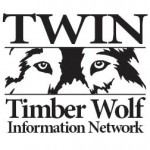By Amy Joi O’Donoghue
SPRINGVILLE — Workers with an expert “capture” company hope to take to the skies Friday over a remote area east of Springville to snare members of what could be Utah’s first wolf pack.
Biologists with the Utah Division of Wildlife Resources stress they can’t be sure of the genetic identity of the four animals until a couple of them are captured and testing is performed.
Kevin Bunnell, wildlife section chief for the division, said blood samples will be taken to determine if the animals are related to the wolves released in Yellowstone National Park. Test results will not be available from a California lab for two weeks. It could be the animals are a wolf hybrid — a mixture of wolf and dog — and in that case they would be put down.
John Shivik, the division’s mammal coordinator, said the animals will also be fitted with sophisticated satellite-linked devices that will track their behavior, which exhibits differently between wolves and wolf hybrids.
While animals with domesticated-dog genetics are prone to wandering and more aimless in their mannerisms, wolves are more focused, determined and efficient in how they behave, Shivik said.
Biologists are optimistic the recent snowfall in the mountains will assist in the animals’ capture, which is a complex undertaking involving a dropped net from a helicopter. Shivik said unless the animals are “clearly” hybrids, they will only be fitted and tested and then released.
For the past 18 months, the division has been investigating reports that there might be wolves east of Springville in north-central Utah.
Last weekend, a coyote control operation in the area had workers with the U.S. Department of Agriculture’s Wildlife Services on alert after they spotted four animals that appeared to be wolves or wolf-dog hybrids.
In fall 2010, a photo taken by a hunter was documented as the first solid evidence of the possibility of wolves in Utah, Bunnell said.
“The photo was taken by a trail camera the hunter had set up in the area,” he said. “An animal that appeared to be a wolf or a wolf-dog hybrid was in one of the photos.”
A year later, a calf kill looked to be the work of a wolf.
“In addition to these two reports,” Bunnell said, “our biologists have responded to several reported sightings they received from the public.”
Cameras have been placed in the areas to help locate the animals prompting the reports.
Wolves, long at the maelstrom of controversy gnawing at Utah’s policymakers, ranchers and environmentalists, are protected under the Endangered Species Act in Utah, except for a small section in the northern part of the state.
Because of those protections, management of wolves falls under the purview of the U.S. Fish and Wildlife Service.
What fate should befall those animals if it is determined they are wolves varies.
Kirk Robinson with the Western Wildlife Conservancy was hailing the possible return of wolves to Utah and said it should be cause for rejoice.
“I think we should celebrate their return,” Robinson said. “I would want to throw a party for them, a homecoming party.”
Robinson said wolves have long been misunderstood and feared by man, despite their obvious and integral role in the balance of the ecosystem.
“Wolves unfortunately play the same role in many people’s imagination today that so-called witches did for 200 to 300 years,” he said.
But Randy Parker, head of the Utah Farm Bureau, said wolves imperil wildlife and livestock and have no place in Utah.
“It’s bringing a very aggressive species into the Utah landscape,” Parker said.
